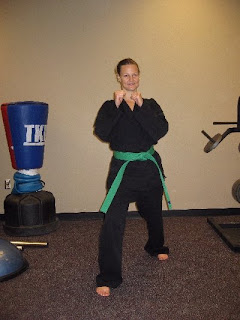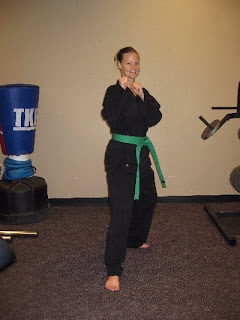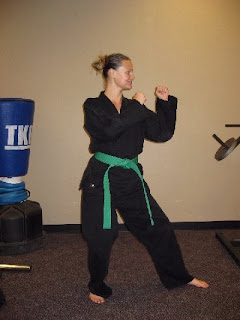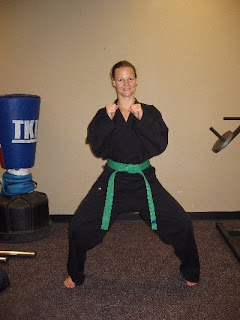Front Stances
Front stances are stances in which most of your weight is on your front foot. These can also be called walking stances, forward stances, and probably several other names I've never heard. Here's Lindsey doing a basic front stance:
 |  |
Note that her shoulders are square to the front, her back leg is nearly straight, and her front knee is bent. Some styles / schools / instructors prefer deeper or shallower stances. That's fine. To each his own. Even some situations require deeper or shallower stances than is typical. What makes a front stance a front stance is weight distribution: Most of the weight is supported by the front foot.
Back Stances
Back stances are stances in which most of your weight is on your back foot. These can also be called "L" stances because your feet make an "L." Here's Lindsey doing a basic back stance:
 |  |
Note that her shoulders are turned to 45 degrees, both knees are bent, and her back is straight and aligned with her back heel. Again, depth is a matter of preference and situation. A variation on the back stance is the cat stance. A cat stance positions the front foot closer to the back foot, and has the heel off the floor. Many Okinawan karate styles (Isshinryu, for example) use cat stance exclusively as its form of back stance. Regardless, what makes a back stance a back stance is weight distribution: Most of the weight is supported by the back foot.
Middle Stances
Middle stances are stances in which the weight is equally distributed. A ready stance is a middle stance, but the best visual example is a horse (or horse-riding) stance. Here's Lindsey doing a horse stance:
 |  |
Note that her back is straight, her knees are back, and her hips are forward. Of course, depth is a matter of preference here, too. The key to a good horse stance is to keep your weight not only in the center between your feet, but balanced front-to-back.
There are other "middle" stances, such as a crane stance, but that will require its own post. If you keep in mind the main aspect of front, back, and middle stances, then regardless of depth, you'll have a strong foundation from which to execute any technique!
No comments:
Post a Comment